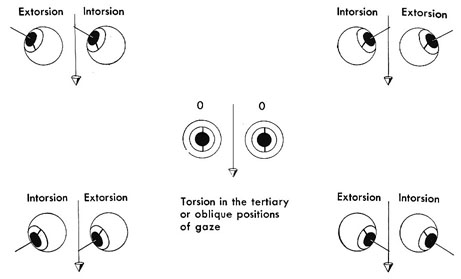|
Chapter 2
TAXONOMY:
THE CLASSIFICATION OF EYE MOVEMENTS
Key words: saccades, pursuits, vergence, VOR, OKN,
conjugacy
Outline
I. Functions of Eye Movements
- Anatomical considerations
Retinal organization (fovea) requires tracking
Location of orbits (forward eye placement) requires vergence
- Tasks performed
Place images on the Fovea
Enhance visual acuity and visibility of interesting objects
Reduce retinal image smear
Focus images of interest
Control light level
Expand field of view
Support stereoscopic depth perception
II. Classification of 5 types of Eye Movements:
Saccades, Pursuits, Vergence, OKN, VOR
- Functional
Image stabilization during body movements (OKN, VOR)
Image tracking of moving objects: saccades, pursuits and vergence
Suppression of stabilization by tracking
- Speed
Saccades (fast movements) - do not require continuous visual
feedback
Pursuits (slow movements) - require continuous visual feedback
- Conjugacy of two eyes
Conjugate (yoked)-version
Disconjugate- vergence
Hering's law- adapted calibration
- Direction for version and vergence
Vertical version- elevation and depression
Vertical vergence- hyper, hypo, supra, infra, sur and deor sumvergence
Horizontal version- ab duction and ad duction (nose ref), dextro,
levo (body ref)
Horizontal vergence- convergence and divergence
Torsional- dextro (clockwise) & levo cyclo (counter cw) version-(body
ref)
Torsion cyclovergence- in and ex cyclo vergence (nose ref)
Functions of eye movements
In order to appreciate problems your patients might
encounter with a faulty eye movement system let's go over some
of the functional benefits of a normal oculomotor system (reference:
Leigh and Zee chapter 1 and Adler chapter 5 ).
First of all there are the anatomical
considerations. 1) Our retina is specialized for enhanced
resolution in the central visual field at the fovea. This
isn't the case in many other mammals, such as the rabbit or even
the cat to some extent. We need to be able to direct the
fovea in any direction in space and to follow moving objects
that interest us. Our foveas give us very high spatial resolution
that assists us in stereo tasks, object recognition, and our
ability to manipulate small objects with our hands. Our large
heads make this difficult to do using the neck by itself with
any degree of speed or precision. 2) The second anatomical
consideration is the forward placement of the eyes in the head
allows us to have large overlap of the visual fields to permit
stereopsis. Binocular fields must be precisely matched to
have good stereo, and vergence eye movements allow us to align
the two eyes with targets over a large range of distances. Vergence
development is rare in non-primates. There is some ability
in cats but not much. It serves us in our manipulation of
tools with our hands at near viewing distances.
We can also look at the benefits provided
by eye movements in terms of vital tasks we perform. 1)
I have already mentioned object recognition and inspection which
is aided by using our foveas. Eye movements expand the regions
of space that we have high resolution. 2) Accommodation
expands the range of distances that we can have high acuity and
clear vision from 5 cm to optical infinity. When we become
presbyopic small pupil size serves a similar function at the
expense of night vision sensitivity. 3) Pupil size is normally
adjusted to give us an ability to regulate light level by a factor
of 10. 4) Having forward placed eyes has the benefit
of allowing stereopsis but it has the disadvantage of reducing
our visual field from 360 degrees to about 200 degrees. Many
animals with laterally placed eyes can literally see behind their
heads and have panoramic vision. Eye movements let us expand
our field of view. 5) As mentioned earlier, vergence
eye movements give us the ability to fuse targets on corresponding
retinal points such as the fovea and have stereopsis. 6)
Eye movements also allow us to stabilize our visual field as
we move about and to stabilize images of moving objects as they
move about. The stabilization of the visual field during
our motion is a task performed by any animal that has the ability
to move. Image tracking of small moving objects is only
seen in animals with foveas that need to inspect small moving
objects. The function of tracking is to bring targets to
the fovea and keep them there.
These latter two tasks, image stabilization during locomotion
and image tracking, each have several types of eye movements
that support these activities. In all, there are five types
of eye movements (VOR, OKN, saccades, pursuits, and vergence)
and they can be classified in many different ways. They
were first classified by Raymond Dodge in 1902.
Classification of movements
Classification
by Funcion
The first and most general classification scheme is
by function. Either the eye movements stabilize the motion
of the retinal image generated by our own body and head movements
or they stabilize the image of a moving object in space. In
the former case the whole retinal image is moving in unison whereas
in the latter case only the objects image is moving and when
you track that object you cause the previously stable background
retinal image to move. This puts these two tasks in conflict
with one another. You can't track the moving object at the
same time you stabilize the background field motion. Fortunately
image tracking efforts are able to suppress the background stabilization
reflexes. Animals like the rabbit don't have this ability. Their
eyes mainly serve to stabilize background motion and they are
unable to follow small moving objects with their eyes. |
|
